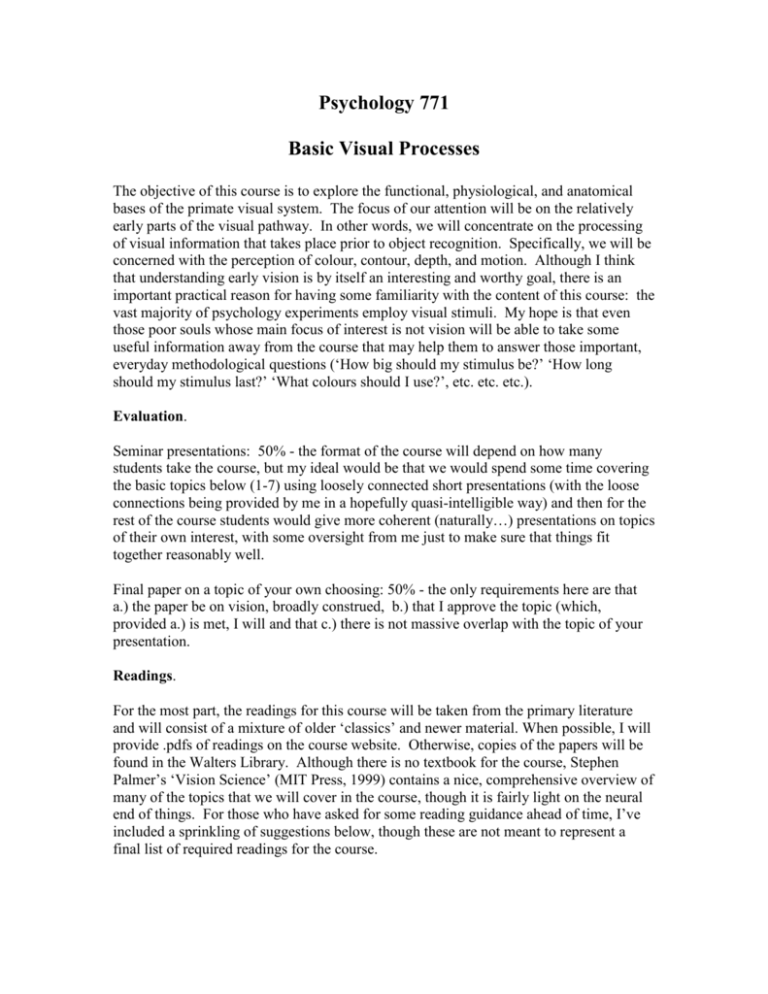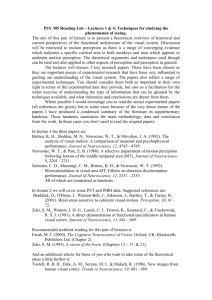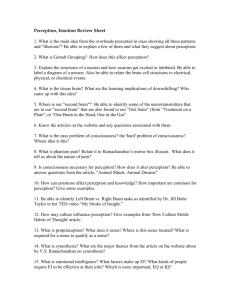Psychology 771
advertisement

Psychology 771 Basic Visual Processes The objective of this course is to explore the functional, physiological, and anatomical bases of the primate visual system. The focus of our attention will be on the relatively early parts of the visual pathway. In other words, we will concentrate on the processing of visual information that takes place prior to object recognition. Specifically, we will be concerned with the perception of colour, contour, depth, and motion. Although I think that understanding early vision is by itself an interesting and worthy goal, there is an important practical reason for having some familiarity with the content of this course: the vast majority of psychology experiments employ visual stimuli. My hope is that even those poor souls whose main focus of interest is not vision will be able to take some useful information away from the course that may help them to answer those important, everyday methodological questions (‘How big should my stimulus be?’ ‘How long should my stimulus last?’ ‘What colours should I use?’, etc. etc. etc.). Evaluation. Seminar presentations: 50% - the format of the course will depend on how many students take the course, but my ideal would be that we would spend some time covering the basic topics below (1-7) using loosely connected short presentations (with the loose connections being provided by me in a hopefully quasi-intelligible way) and then for the rest of the course students would give more coherent (naturally…) presentations on topics of their own interest, with some oversight from me just to make sure that things fit together reasonably well. Final paper on a topic of your own choosing: 50% - the only requirements here are that a.) the paper be on vision, broadly construed, b.) that I approve the topic (which, provided a.) is met, I will and that c.) there is not massive overlap with the topic of your presentation. Readings. For the most part, the readings for this course will be taken from the primary literature and will consist of a mixture of older ‘classics’ and newer material. When possible, I will provide .pdfs of readings on the course website. Otherwise, copies of the papers will be found in the Walters Library. Although there is no textbook for the course, Stephen Palmer’s ‘Vision Science’ (MIT Press, 1999) contains a nice, comprehensive overview of many of the topics that we will cover in the course, though it is fairly light on the neural end of things. For those who have asked for some reading guidance ahead of time, I’ve included a sprinkling of suggestions below, though these are not meant to represent a final list of required readings for the course. Syllabus January 8. Ancient history and theory in perception -the origins of psychophysics (a mercifully brief treatment) -the influence of brain science -major themes in perceptual psychology (ecological, computational, and constructivist approaches) Palmer, S. (1999). Vision Science, From Photons to Phenomenology, MIT Press: Cambridge. Chapter 2 (Theoretical approaches to vision). January 15. A primer of visual system anatomy and physiology -the structure of the eye, optics, line spread functions -the retina -central visual pathways -the organization of VI -higher visual cortical areas Nolte, J. (2002). The human brain: An introduction to its functional anatomy, Mosby: St. Louis, Chapter 17. -a neuroanatomy textbook but still filled with lots of interesting physiological and functional facts. The chapter on vision is a worthwhile introduction. Wandell, B. (1995). Foundations of Vision, Sinauer, Sunderland. Chapters 5 and 6. -this is a more difficult book than the Nolte book and parts of it presuppose some understanding of linear systems theory (but even if you skip the matrix algebra these chapters are useful). Chapter 6 also contains a very thoughtful section on the scope and limits of biological approaches to vision. Lennie, P. (1998). Single units and visual cortical organization. Perception, 1998. -this paper poses some challenges to some of the conventional views of hierarchical processing through cortex. Martin, K.A.C. (1992). Visual cortex parallel pathways converge. Current Biology, 2, 555-557. The perception of colour -Isaac Newton and the first psychological theory -colour mixture -opponent processing vs. trichromaticity -colour constancy -neural bases of colour processing -colour blindness January 22 Hurvich, L. M. & Jamieson, D. (1957). An opponent process theory of color vision. Psychological Review, 64, 384-404. DeValois, R. L. & Jacobs, G. H. (1968). Primate color vision., Science, 162(3853), 533-540. Regan, B. C., Julliot, C, Simmon, B. Vienot, F., Charles-Dominique, P. & Mollon, J.D. (2001) Fruits, foliage, and the evolution of primate colour vision. Philosophical Transactions of the Royal Society of London B, 356, 229-283. January 29 Zeki (1983). Colour coding in the cerebral cortex: The reaction of cells in monkey visual cortex to wavelengths and colours. Neuroscience, 9, 741-765. Cowey, A. & Heywood, C. (1995). There’s more to colour than meets the eye. Behavioural Brain Research, 71(1-2), 89-100. Hadjikhani, N., Liu, A. K., Dale, A. M., Cavanagh, P., & Tootell, R. B. H. (1998). Retinotopy and color sensitivity in human visual cortical area V8. Nature Neuroscience, 1, 235-241. Wade, A. R., Brewer, A. A., Rieger, J. W., & Wandell, B. A. (2002). Functional measurements of human ventral occipital cortex: Retinotopy and colour. Philosophical Transactions of the Royal Society of London B, 357, 963-973. 1. The perception of contours -Hubel and Wiesel’s experiments -the DeValois’ and multiple spatial frequency channels -David Marr and the primal sketch -non-Fourier contours February 5 Hubel, D. H. & Wiesel, T. N. (1977). Functional architecture of macaque visual cortex. Proceedings of the Royal Society of London, B, 198, 1-59. Blakemore C. & Campbell, F. W. (1969). On the existence of neurons in the human visual system selectively sensitive to the orientation and size of retinal images. Journal of Physiology (London), 203, 237-260. Graham, N. & Nachmias, J. (1971).Detection of grating patterns containing two spatial frequencies: A comparison of single-channel and multiple-channel models. Vision Research, 11, 251-259. February 12 Tootell, R. B. H., Silverman, M. S. & De Valois, R. L. (1981). Spatial frequency columns in primary visual cortex. Science, 214, 813-815. Mareschal, I. & Baker. C. L., Jr. (1998). A cortical locus for the processing of contrastdefined contours. Nature Neuroscience, 1(2), 150-154. Baker, C. L. Jr., & Mareschal, I. (2001) Processing of second-order stimuli in the visual cortex. Progress in Brain Research, 134, 171-191. . 6. The perception of depth -physiological cues -stereopsis and the correspondence problem -the neural basis of stereo vision -pictorial cues -cues from motion -the combination of cues -depth for form vs. distance for action February 26 Marr, D. & Poggio, T. (1979). A computational theory of human stereo vision. Proceedings of the Royal Society of London, B, 204, 301-328. Ohzawa, I. DeAngelis, G. C. & Freeman R. C. (1990). Stereoscopic depth discrimination in the visual cortex: Neurons ideally suited as disparity detectors. Science, 249, 10371041. Cumming, B. G. (2002). An unexpected specialization for horizontal disparity in primate primary visual cortex. Nature, 418, 633-636. March 5 Koenderink, J. J., van Doorn, A. J. & Kappers, A. M. L., (1996). Pictorial surface attitude and local depth comparisons. Perception & Psychophysics, 58(2), 163-173. Landy, M. S., Maloney, L. T., Johnston, E. B. & Young, M. (1995). Measurement and modeling of depth cue combination: In defense of weak fusion. Vision Research, 35(3), 389-412. Hillis JM, Ernst MO, Banks MS, Landy MS. (2002). Combining sensory information: mandatory fusion within, but not between, senses. Science, 298 (5598), 1627-1630. 2. The perception of form -region segmentation -texture perception -completion -figure-ground discrimination -illusory contours March 12 Palmer, S. E. & Rock, I. (1994). Rethinking perceptual organization: The role of uniform connectedness. Psychological Bulletin and Review, 1, 29-55. Kubovy, M. & Wagemans, J. (1995). Grouping by proximity and multistability in dot lattices: A quantitative Gestalt theory. Psychological Science, 6(4), 225-234. Julesz, B. (1981). Textons, the elements of texture perception and their interactions. Nature, 290(5802), 91-97. Malik, J. & Perona, P. (1990). Preattentive texture discrimination with early vision mechanisms. Journal of the Optical Society of America A, 7(5), 923-932. March 19 Baumann R, van der Zwan R, Peterhans E. (1997). Figure-ground segregation at contours: a neural mechanism in the visual cortex of the alert monkey. European Journal of Neuroscience, 9(6), 1290-1303. Von der Heydt, R., Peterhans, E. & Baumgartner, G. (1984). Illusory contours and cortical neuron responses, Science, 224(4654), 1260-1262. Heider B, Spillmann L, Peterhans E. (2002). Stereoscopic illusory contours--cortical neuron responses and human perception. Journal of Cognitive Neuroscience, 14(7), 10189-1029. 7. The perception of motion -simple motion -motion plaids and pattern motion -optic flow -biological motion -event and causality perception March 26 Movshon, JA, Adelson MS, Gizzi MS, Newsome WT (1986). The analysis of moving visual patterns. In C. Chagas, R. Gattass, and C. Gross (eds) Pattern Recognition Mechanisms, NY: Springer-Verlag. (148-164). Pasternak T, Albano JE and Harvitt, DM (1990). The role of directionally selective neurons in the perception of global motion. Journal of Neuroscience, 10, 3079-3086. Salzman, CD, Murasugi CM, Britten KH and Newsome WT. (1992) Microstimulation in visual area MT: Effects on direction discrimination performance. Journal of Neuroscience, 12(6), 2331-2355. April 2 Duffy CJ. (1998) MST neurons respond to optic flow and translational movement. Journal of Neurophysiology, 80(4), 1816-1827. E. Grossman, M. Donnelly, R. Price, D. Pickens, V. Morgan, G. Neighbor, & R. Blake (2000). Brain areas involved in perception of biological motion. Journal of Cognitive Neuroscience, 12(5), 711-720. Scholl BJ, Nakayama K. (2002)Causal capture: contextual effects on the perception of collision events. Psychological Science, 13(6), 493-498.






